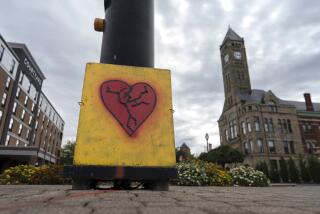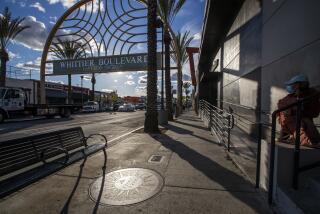A Struggling City Fights Perceptions
EAST ST. LOUIS, Ill. — This is a boarded-up and beaten-down city, a city of abandoned buildings and lots heaped with rubble, of windows secured with iron grates.
But it is, as well, a city with ambition.
So it stung when a lawmaker from across the Mississippi River, in Missouri, recently slammed East St. Louis as too scary to visit unarmed. Dismissing talk that the Cardinals baseball team might build a new stadium here, Missouri state Rep. Jim Murphy told a TV interviewer that fans would never come. “To go over to East St. Louis,” he said, “you’ll have to get your rifle.”
The remark stirred a furor on both sides of the river.
Nearly all of the 31,500 residents of East St. Louis are black. Murphy, a Republican from suburban St. Louis, is white. When his comment hit the air late last month, local African American leaders held a news conference to denounce it as racist. Murphy showed up unannounced to defend himself--and got into a shouting match with a prominent black clergyman.
Lawmaker Says News Influenced Comment
When Murphy tried an apology of sorts a few days later, he only made things worse. Insisting that he had no idea East St. Louis was 98% black, the veteran lawmaker said he based his comments not on racist stereotypes, but on news stories about out-of-control crime.
“Every month or so, you see photos of dead bodies turning up over there. Is that the most desirable place to locate a stadium that will draw families?” he said. “There was nothing derogatory meant. My heart goes out to the people of East St. Louis if it’s really as bad as the media make it seem.”
City Manager Harvey E. Henderson could do without such condolences.
In office for a year and a half, Henderson has taken on the challenge of bringing more tourists into his impoverished community. He’s not starting quite from scratch: The Casino Queen, a riverboat moored here, already draws out-of-town gamblers by the thousands to play blackjack, roulette and Caribbean stud poker. But most of those visitors never venture past the Casino Queen parking lot, right off the freeway.
Henderson’s goal is to bring folks into East St. Louis itself: To the museum honoring dance legend Katherine Dunham, to the boyhood home (once it’s renovated) of jazz great Miles Davis, to the athletic center founded by track-and-field star Jackie Joyner-Kersee.
Even more critical, he has to convince developers that they can earn money here. The baseball stadium likely is out of reach; the Cardinals are eager to build a new ballpark in downtown St. Louis if they can secure more than $200 million in public financing. If that deal falls through, however, East St. Louis stands ready to woo the team.
Despite Crime, Tourism Projects in the Pipeline
In the meantime, Henderson is courting other attractions.
Henderson says one major project should get underway here this year: a huge riverfront hall that will host touring cultural exhibits too big for ordinary museums--such as recent shows on imperial Russia and ancient Egypt.
Other ideas he has in mind include a marina, a swanky hotel and a factory outlet mall. The trick is to make the case to developers that people will come from all over the region to shop here, or to play golf along the Mississippi--that they won’t be scared away by an East St. Louis address.
Comments like Murphy’s do not help.
“I think Jim Murphy ought to be ashamed of himself,” Henderson fumed. “You don’t need a rifle to come here. It’s a slap in the face.”
For all his boosterism, however, Henderson acknowledges that East St. Louis faces serious problems--starting with a chronically understaffed police force. Henderson has promised to add six more officers this year. In the meantime, Police Chief Delbert Marion has said, the force can do little other than respond to 911 calls.
There are not enough officers to crack down on the city’s notorious strip areas--crumbling blocks where prostitutes and drug pushers strut day and night, Marion said. There are not enough detectives to investigate nonviolent crimes unless there’s an obvious suspect. The force cannot even spare an officer to guard Mayor Debra Powell, who has said she fears for her life because a suspicious character is harassing her.
Police Work Questioned in Spate of Killings
The Police Department’s reputation is shaky as well because there has been little progress in a notorious string of homicides, possibly the work of a serial killer. In the past two years, the corpses of nine women have turned up in the city. Another four bodies have been discovered nearby. Late last year, Illinois state police let it be known that they had a suspect in several of the killings. They even knew where their man was: Serving time in an Illinois prison for an unrelated felony. But a few weeks ago, they acknowledged that they had lost track of the suspect. He had been released from prison and had vanished.
Such news hardly bolsters public confidence in East St. Louis. And there are other woes here besides. The city is desperately poor: One in every five families lives in public housing, and more than half the children live in poverty. While city officials say they are making progress knocking down abandoned buildings, most streets sag with decay.
Problems Here Common in Any City, Some Say
Still, some longtime residents--and some tourists who come to gamble at the Casino Queen--say the city’s bad reputation is not justified. Sure, there are some neighborhoods that they might not want to stroll through at night, or alone during the day. But they could say the same about any other big city.
“We’ve got neighborhoods in St. Louis with multimillion-dollar homes where people are being robbed and shot,” said Steve Thompson, 28, of St. Louis. “I look at it as part of life. I don’t classify particular neighborhoods as good or bad.”
At her desk in East St Louis’ stately new public library--an airy $4.5-million building completed last year--interim manager Madie Dowell agreed.
“Crime’s not so bad here,” she said. “It used to be worse, believe it or not.”
Dowell thought for a moment about Murphy’s remark, then dismissed it with a scornful wave. “He’s entitled to his opinion,” she said, “but honestly, people come here all the time.”
More to Read
Sign up for Essential California
The most important California stories and recommendations in your inbox every morning.
You may occasionally receive promotional content from the Los Angeles Times.










